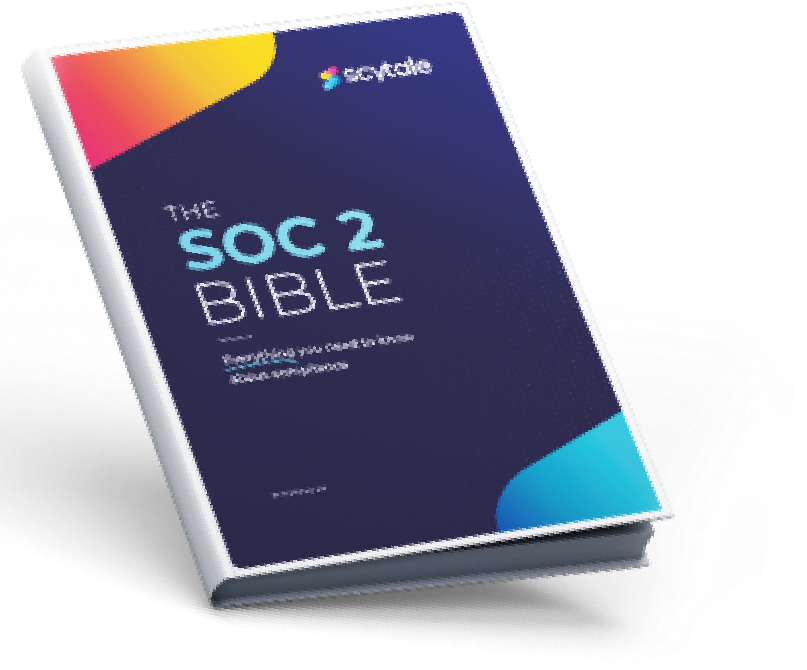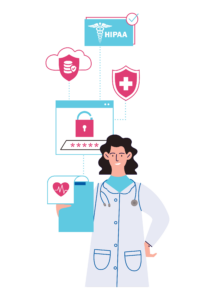So, you need a security framework for your business? Or perhaps you’re just really curious about what on earth we keep hammering on about.
Nevertheless, we’re diving into HIPAA and SOC 2 once again, but this time we’re putting the two against each other to see how they compare. Any starting bets for a favorite?
Before getting into the nitty-gritty, there’s one overarching disclaimer that needs to be addressed immediately (and throughout the article) – if your organization classifies as a covered entity or a business associate, you’re subject to The HIPAA Privacy Rule. That means that there’s little wiggle room for decision-making. Why? Well, HIPAA compliance is a federal law.
SOC 2, however, is a voluntary security framework. But that doesn’t mean that there aren’t numerous benefits of implementing each or both.
Here’s what you need to know if you’d like to compare the two and see which one would best benefit your organization.
GET COMPLIANT 90% FASTER WITH AUTOMATION
SOC 2 vs. HIPAA compliance bingo
Can your business tick off three in a row? Actually, if any of the below relates to your business, it may be time to pick up what we’re putting down. Here are some general (but important) questions:
| SOC 2 | HIPAA |
| You’re a cloud-based service organization that stores or processes sensitive customer data. | Your organization deals with protected health information (PHI). |
| You’d like a competitive edge against other players in the market. | You’re a covered entity or business associate and handle PHI. |
| Your business would benefit from reduced security risks and security oversight across the organization. | You could benefit from a security framework that improves patient/client safety culture and prevents violations. |
If any of the above applies to your business, congratulations – your organization should be exploring SOC 2 or HIPAA compliance. To better understand each, here’s a closer look at SOC 2 and HIPAA and what it means for your business.
What is SOC 2?
A SOC 2 report is governed by AICPA’s Five Trust Principles and addresses a service organization’s information security controls. In a nutshell, SOC 2 reports ensure that service organizations don’t just talk the talk but have concrete controls, processes, and systems that safeguard the way they store, process, and transmit customer data. Depending on which of the five TSPs relates to your organization, a SOC 2 report will assess a company’s IT control environment and policies.
The 5 TSPs are Security (common criteria), Availability, Confidentiality, Processing Integrity, and Privacy. Out of these five principles, the Security TSP is obligatory.
Speaking of obligatory, let’s look at HIPAA.

What is HIPAA?
To understand HIPAA, you must familiarize yourself with a little (not so little) thing called protected health information (PHI). PHI includes any and all individually identifiable information related to a person’s health. This includes past, present, and future information about healthcare or payment.
If the name didn’t give it away, we’ll state the obvious – protected health information is protected. But not just by any organization, but by federal law. This means that if any organization handles PHI physically or electronically, they are subject to The Privacy Rule. If you’re subject to The Privacy Rule, HIPAA compliance is required by law, and without it, you’re in for some pretty hefty fines (and possible criminal charges).
Who should be HIPAA compliant?
The Privacy Rule dictates which organizations are required by law to comply with HIPAA. These organizations fall into two categories; Covered Entities (CE) and Business Associates (BA). A common misconception is that HIPAA compliance only applies to those within the healthcare industry. However, this is far from the truth. If your business classifies as a CE or BA – tag, you’re it.
However, for such critical compliance, there is far too much gray area regarding who classifies as a CE and who doesn’t. That’s why we straightened out the facts and pinpointed who needs to be HIPAA compliant. Understanding the criteria for classification as a CE or BA is crucial for compliance.
Who should be SOC 2 compliant?
Generally, SOC 2 draws in businesses with cloud-based products who want to establish robust InfoSec policies and controls. This is mainly due to the fact that it’s either requested by a prospect or to give them a competitive advantage. However, the reality is that businesses can no longer afford to be on the defense when it comes to client data security. SOC 2 enables enterprises to establish a security culture and better identify and mitigate security threats.
The guiding principles: The 5 trust principles vs. the HIPAA rules
SOC 2 is guided by the five trust principles developed by the American Institute of Certified Public Accountants (AICPA) and cover the following categories: Security, Availability, Processing Integrity, Confidentiality, and Privacy. Here’s a quick overview of what you need to know:
| Security | This principle covers InfoSec and how to safeguard data through security controls. |
| Availability | The availability principle tests how reliable your platform is, including client service and uptime. |
| Processing Integrity | This establishes the accuracy of a platform’s processing systems and the margin of errors. |
| Confidentiality | The confidentiality principle tests how effective the access controls are and whether the data is restricted to authorized individuals only. |
| Privacy | This principle guides the process in which organizations obtain, store and transfer sensitive data. |
Out of the 5 TSPs, businesses can choose which principles are relevant to their business before the audit. This allows businesses to tailor their SOC 2 and focus on specific business needs. However, out of the five principles, there is a “common criteria” that all businesses must adhere to be SOC 2 compliant. This falls under the “Security Principle.”
HIPAA, on the other hand, is guided by four core rules that all work together for both regulatory compliance and healthcare data security. These four rules are not flexible or optional and are implemented in order to better protect PHI. Here’s a quick overview of the four HIPAA rules:
| The Privacy Rule | The Privacy Rule offers strict guidelines and a quintessential example of how to protect PHI. It also discerns who needs to be compliant and who doesn’t. |
| The Security Rule | The Security Rule establishes set requirements and controls that an organization must implement in order to adhere to the objectives set out by the Privacy Rule. It also specifically deals with all e-PHI, which is PHI in digital form. |
| The Breach Notification Rule | This Rule sets out a mandatory process that organizations must follow in the case of a violation or data breach. |
| The Omnibus Rule | The Omnibus Rule is an addendum that dictates how covered entities and business associates should set up a Business Associate Agreement (BAA). A BAA ensures that all parties involved are aware of their responsibility and role in HIPAA compliance. |
Spot the difference: SOC 2 vs. HIPAA
Although SOC 2 and HIPAA share similar requirements and controls, the differences are vast, especially when considering the flexibility of SOC 2. Here are a few core differences between the two to better understand their purpose.
Data breaches and violations
HIPAA: In the event of a data breach, the HIPAA breach notification rule sets out mandatory steps that Covered Entities and Business Associates must follow. This includes notifying all individuals who were affected by the breach of PHI. In the case of more severe breaches (500 individuals or more), organizations are required by law to provide notice to the media within 60 days. Covered entities must also notify The Secretary.
SOC 2: SOC 2 doesn’t require any mandatory rules when it comes to breach notification, although there are some recommendations through guidelines and efficient security awareness training.
The purpose
HIPAA: HIPAA specifically regulates how covered entities and business associates obtain, handle, store and transfer PHI. Its primary purpose is to protect PHI.
SOC 2: SOC 2 is voluntary and more flexible than HIPAA and is an audit process that allows organizations to test their company’s systems, policies, and controls to ensure that it securely stores client data.
The process
HIPAA: You either abide by the law or you don’t. This means that you can’t beHIPAA ‘certified.’ Although, The Office for Civil Rights (OCR) will provide routine support to new issues affecting health care. The OCR is also responsible for investigating violations and enforcing regulations. To ensure HIPAA compliance, businesses undergo routine HIPAA self-assessments and ongoing risk management.
SOC 2: The process of SOC 2 compliance is a bit more flexible, and businesses can undergo annual audits based on the relevant TSPs. The most significant benefit of SOC 2 is that the audit will be unique to your organization and its specific security requirements.
A meeting point of SOC 2 and HIPAA compliance
If you’re a cloud-based product that also happens to deal with PHI, it’s important to address the overlap between SOC 2 and HIPAA. A SOC 2 attestation will ensure that your organization has the necessary security controls and policies to protect data (along with any of the five TSPs that are relevant).
However, SOC 2 does not and can not substitute HIPAA compliance. Why? You may have guessed it by now, but it begs to repeat: HIPAA compliance is required by law for those subject to The Privacy Rule. However, the scope of HIPAA compliance still includes other additional (and different) rules and requirements. Although SOC 2 might overlap with a few of HIPAA’s requirements, it still won’t tick all the boxes requested by The Department of Health and Human Services (HHS).
Double-up: The benefits of both compliance frameworks
For many organizations, the importance of security controls is only emphasized after the damage has been done. In addition to ensuring that your business takes a proactive approach to security compliance, here are a few core benefits that both SOC 2 and HIPAA compliance share.
It’s proactive and cost-effective
Both HIPAA violations and data breaches lead to significant losses to a business’s finances and reputation. By being HIPAA compliant, businesses can reduce penalties and the possibility of lawsuits. In comparison, SOC 2 compliance helps mitigate financial and reputational losses by identifying and addressing potential security gaps within the internal processes and procedures.
It increases customer trust
Let’s be real; no client would be comfortable going into business with an entity they do not trust. HIPAA and SOC 2 compliance proves that your organization is informed and updated on the necessary security protocols, policies, and controls. This increases client/patient trust and establishes a reliable workforce with security embedded into its DNA.
It adds a competitive advantage
Both HIPAA compliance and SOC 2 attestation are monumental pillars of a security-conscious brand. As data breaches and violations become more frequent and protecting information more critical, clients aren’t likely to settle for anything less than exceptional security.
SOC 2 to HIPAA Mapping
Naturally, if you’re en route to your destination and you pass important landmarks along the way, it makes sense to grasp the opportunity and stop while you’re there. The same principle applies to SOC 2 mapping. Simultaneously tackling both HIPAA and SOC 2 requirements can save your organization time, money, and resource allocation. It’s important to note, however, that AICPA’s SOC 2 mapping recognizes the overlap between security frameworks and highlights similar controls and policies that could benefit from multiple compliance frameworks. This ensures an effective and efficient approach toward compliance.
Automate compliance with Scytale
Ultimately, achieving compliance with HIPAA or SOC 2 is not a simple, quick process. However, it doesn’t have to be an overly burdensome task either. With Scytale’s automated solutions, you can streamline and simplify the process of attaining HIPAA compliance, SOC 2 compliance, or both, keeping you ahead of the compliance curve efficiently.











